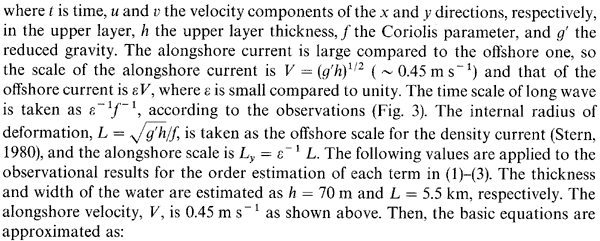4. Discussion
4.1. Characteristic of the coastal current
The thermal front moved at 0.6-0.7 m s-1 along the Sagami Bay coast cyclonically and its speed was nearly equal to the maximum velocity observed at the moored station, EN, near the coast. The warm water formed a density front where it appeared on the surface at the distance of 15 km from the coast. From these results, the warm water intrusion is considered to behave as a density current in a rotating fluid (Stern, 1980; Stern et al., 1982; Kubokawa and Hanawa, 1984a,b; Griffiths, 1986). Thus, we will investigate the dynamics of the density current, using the observational results. The temperature and salinity distributions, as shown in Fig.6, can allow application of a two-layer model. We choose a right-hand coordinate system where the positive x-axis points the offshore direction and the y-axis lies along the coastline at x = 0. The motion is assumed to be limited to the upper layer. The momentum and continuity equations of non-viscous fluid have the following form;
ut + uux + vuy - fv = - g'hx' (1)
vt + uvx + vvy +fu = - g'hy' (2)
ht + (uh)x + (hv)y = 0, (3)

-fv = - g'hx' (4)
vt + uvx + vvy +fu = - g'hy' (5)
ht + (uh)x + (vh)y = 0. (6)
The equations are the same as those of Kubokawa and Hanawa (1984b) who explained the Kyucho at the Sagami Bay coast in April 1975 as the density current in a rotating fluid. They indicated the coastal density current as a shock wave of the semigeostrophic coastal wave.